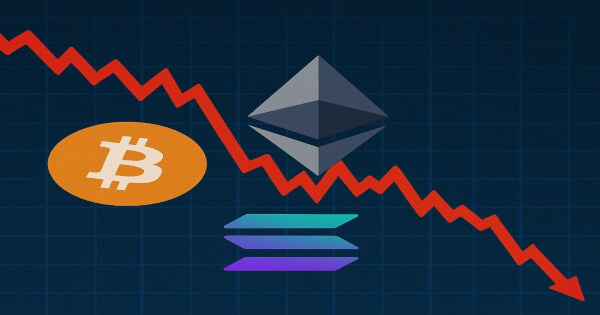Crypto Crash October 2025: What Triggered the Market Freefall and How Did Investors Hedge?
Khushi V Rangdhol Oct 02, 2025 16:42
On October 10–11, 2025, the crypto market crashed, losing $370B. Triggers included U.S.-China tensions, excessive leverage, and liquidity issues. Investors hedged through options, diversification, and buying dips.

The cryptocurrency market went through one of its worst crashes on October 10–11, 2025, erasing over $370 billion in market capitalization in just hours. Bitcoin fell from about $123,000 to near $107,000, while Ethereum, Solana, Cardano, XRP, and most altcoins dropped between 20% and 70%, with meme tokens plunging almost to zero. The rapid sell-off left seasoned and new investors scrambling to limit losses and protect their portfolios.
Triggers Behind the Collapse
- Geopolitical Shock:
The immediate trigger was a sudden escalation in U.S.-China trade tensions as President Trump announced a massive tariff on Chinese tech exports. This sent shockwaves through financial markets, shaking global risk sentiment and pushing investors out of speculative assets like crypto. - Excess Leverage:
Record amounts of leverage built up across futures and derivative markets turned routine selling into a cascade of forced liquidations. More than $19 billion in leveraged positions were closed as exchanges moved to protect collateral, wiping out entire portfolios and adding to selling pressure. - Liquidity Crunch:
Market makers quickly pulled liquidity from major exchanges, worried about their balance sheets as volatility soared. This withdrawal caused crypto markets to lose more than 80% of their market depth in minutes, amplifying price swings and making it impossible for traders to exit positions without severe losses. - ETF Outflows and Institutional Selling:
Spot Bitcoin and Ethereum ETFs saw record outflows, as institutions rushed to redeem shares and limit downside exposure. Large institutional players added to the selling, accelerating declines and making recovery more difficult.
How Did Investors Hedge?
- Options and Futures:
Traders shifted quickly to options markets, buying short-term puts for protection and rolling over hedges to defend against further volatility. Open interest and put-call ratios spiked, indicating heavy demand for downside coverage in Bitcoin and Ethereum. - Diversification:
Investors holding stablecoins, gold, and U.S. Treasury bonds were temporarily shielded as capital fled from high-risk assets. Some funds rotated into regulated financial products or sought yield in higher grade DeFi protocols with better track records of security and liquidity. - Deleveraging and Risk Controls:
Sophisticated investors reduced leverage, moved to spot holdings, and shifted exposure away from thinly traded altcoins and meme tokens. Most experts recommend buying and holding spot crypto, managing size and volatility, and avoiding aggressive leverage. - Buying the Dip:
As prices stabilized, capital began trickling back in—mainly from institutional buyers seizing lower prices on fundamentally strong assets like Bitcoin and Ethereum. This provided much-needed liquidity and stabilized markets in the days following the crash.
Conclusion
The October 2025 crypto crash stands out as the most severe 24-hour wipeout in history, driven by global events, excessive leverage, vanishing liquidity, and institutional response. Investors learned hard lessons about leverage risks and the critical role of diversification and hedging strategies in managing digital asset volatility. Despite the dramatic fall, recovery signs emerged quickly, showing that the crypto market—while highly volatile—is far from dead and continues to mature each cycle.
Sources: reuters.com, nasdaq.com, Citationneeded.news, chainup.com, ig.com, coinedition.com, ebc.com, economictimes.com, cnbc.com, cnn.com, coindesk.com, cryptoslate.com, investopedia.com, aol.com
Image source: Shutterstock
.jpg)
